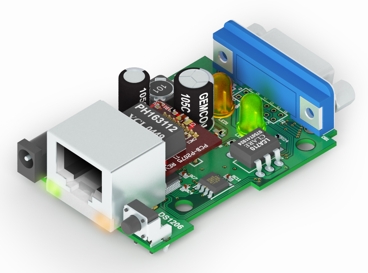DS1206N

Introduction
The DS1206N is a Tibbo BASIC/C-programmable board designed primarily for serial-over-IP and serial control applications. Being small enough to fit inside your product, the board offers a rapid development alternative to using modules, which require making new host PCB.
The DS1206N features a multi-channel serial port. The board has a single serial port connector and is priced as a single-port product, yet it packs four independent serial channels. Have no use for those DSR and DTR lines? Turn them into the RX and TX lines of an additional serial channel. Don't want CTS and RTS either? That's one more channel! In total, there are 15 different configurations to choose from.
The board is supplied in three versions offering various serial port and power options (see below).
The DS1206N is fully supported by Tibbo IDE (TIDE) and a programming platform that covers all hardware facilities of the board. This product ships preloaded with a fully functional serial-over-IP application. Written in Tibbo BASIC/C, the application is compatible with the Tibbo Device Server Toolkit (TDST) software suite, comes with full source codes, and can be modified by the user.
Available Models
The board is supplied in three versions.
The DS1206N-RS is essentially a DS1206 without a housing. The board has a proper RS232 port (RS232 transceiver IC and DB9M connector), as well as the power regulator ("12V"-to-3.3V). There is also a power switch that controls "12V" power output on pin 9 of the DB9M connector.
The DS1206N-TM is different from the "-RS" version in that it has a TTL serial port and no power switch. The port is accessible through a 12-pin connector on the PCB. The power regulator of the board can be used to supply 3.3V power to the attached serial device as well.
Finally, the DS1206N-TS is like the "-TM" version, but has no "12V"-to-3.3V power regulator. Instead, an attached serial device is supposed to provide stabilized 3.3V power to the board.
|
Available models and their features |
DS1206N-RS (RS232) |
DS1206N-TM (TTL master) |
DS1206N-TS (TTL slave) |
|
Setup button |
YES |
||
|
Status LEDs |
YES |
||
|
RS232 transceiver & DB9M connector |
YES |
NO |
|
|
TTL interface connector |
NO |
YES |
|
|
Power switch |
YES |
NO |
|
|
Power jack and "12V"-to-3.3V regulator |
YES |
NO |
|
Hardware Features
- Based on a high-performance, purpose-built 88MHz T1000 ASIC
- 10/100Base-T auto-MDIX Ethernet port
- Up to 3.5 serial channels:
- DS1206N-RS: RS232 port (DB9M connector with optional software-controllable "12V" power output)
- DS1206N-TM and "-TS": TTL serial port (pin header) with optional "12V" power input (instead of supplying power through the power jack)
- Baudrates of up to 921,600bps
- None/even/odd/mark/space parity modes
- 7/8 bits/character modes
- Full-duplex mode with optional flow control
- DS-1206N-TM and "-TS": half-duplex mode with direction control
- Flexible mapping with 15 different options, such as RX, TX, CTS, RTS, DSR, and DTR lines on a single channel, and RX, TX, RX2, TX2, RX3, TX3, and RX4 lines on 3.5 channels
- 512KB or 1,024KB flash memory for firmware, application, and data storage
- 2KB EEPROM for data storage
- Four LEDs:
- Green and red status LEDs on top of the device
- Link and speed Ethernet status LEDs on the RJ45 jack
- Software-controlled onboard PLL to select the clock frequency of the device:
- 11.0592MHz with PLL off
- 88.4736MHz with PLL on
- Power:
- DS1206N-RS and "-TM": onboard regulator, 10V~24V input range (12V nominal)
- DS1206N-TS: direct 3.3V input (must be regulated to ±5%)
- Board dimensions: 52.6x38.0mm
- Firmware and Tibbo BASIC/C application are upgradeable through the serial port or network
- Tibbo BASIC/C application can be debugged through the network and no additional debugging hardware, such as in-circuit emulator, is required
- Also available as a DS1206 (DS1206N board with housing)
Programming Features
The DS1206N runs Tibbo OS (TiOS). The following is a list of features supported by its programming platform:
- Objects:
- button — monitors the setup button
- fd — manages flash memory file system and direct sector access
- io — handles I/O lines, ports, and interrupts
- net — controls the Ethernet port
- pat — "plays" patterns on green and red status LEDs
- romfile — facilitates access to resource files (fixed data)
- ser — in charge of serial channels
- sock — socket communications (up to 16 UDP, TCP, and HTTP sessions)
- stor — provides access to the EEPROM
- sys — in charge of general device functionality
- Variable Types: Byte, char, integer (word), short, dword, long, real, string, plus user-defined arrays and structures
- Function Groups: 27 string functions, eight date/time conversion functions, encryption/hash calculation functions (AES128, RC4, MD5, SHA-1), and more
